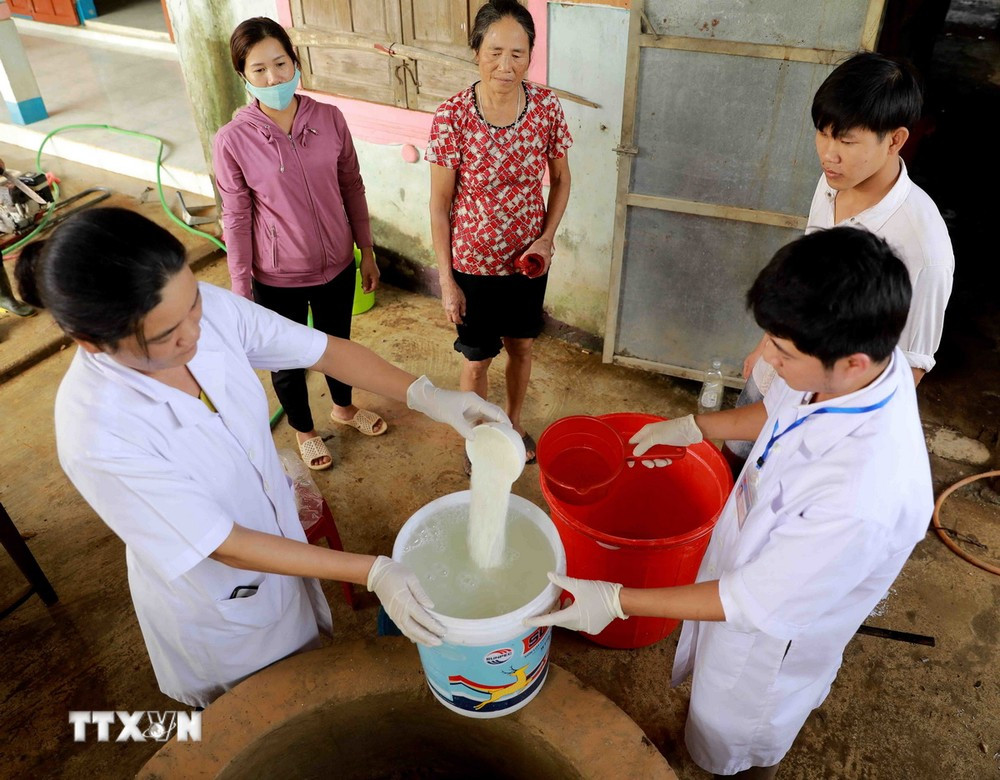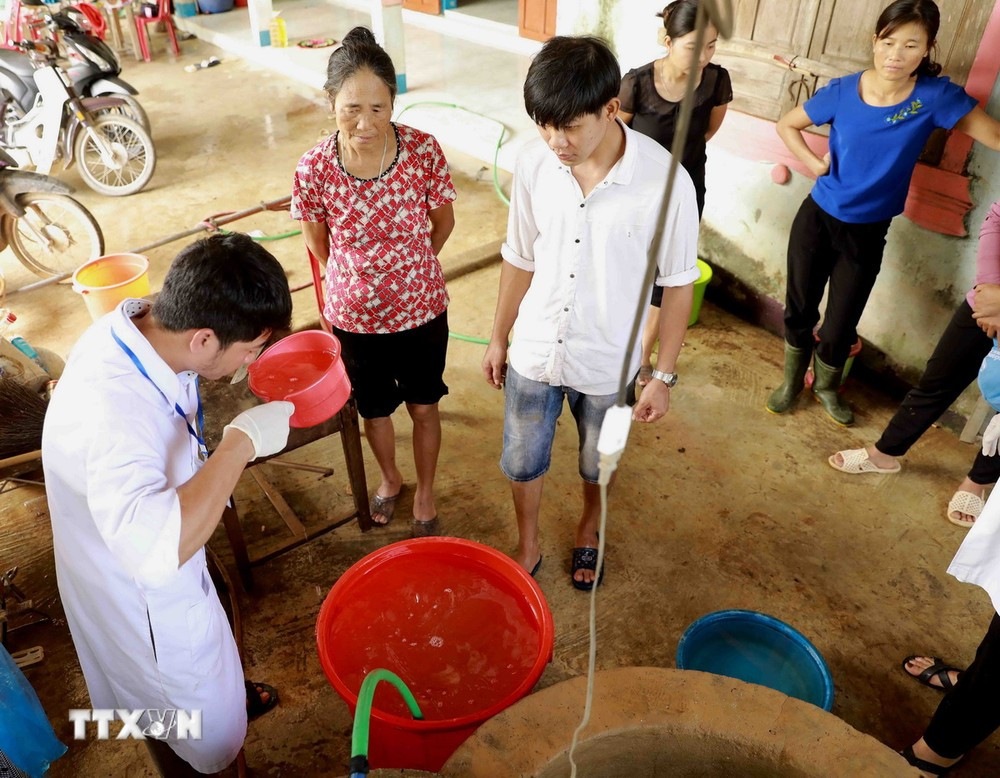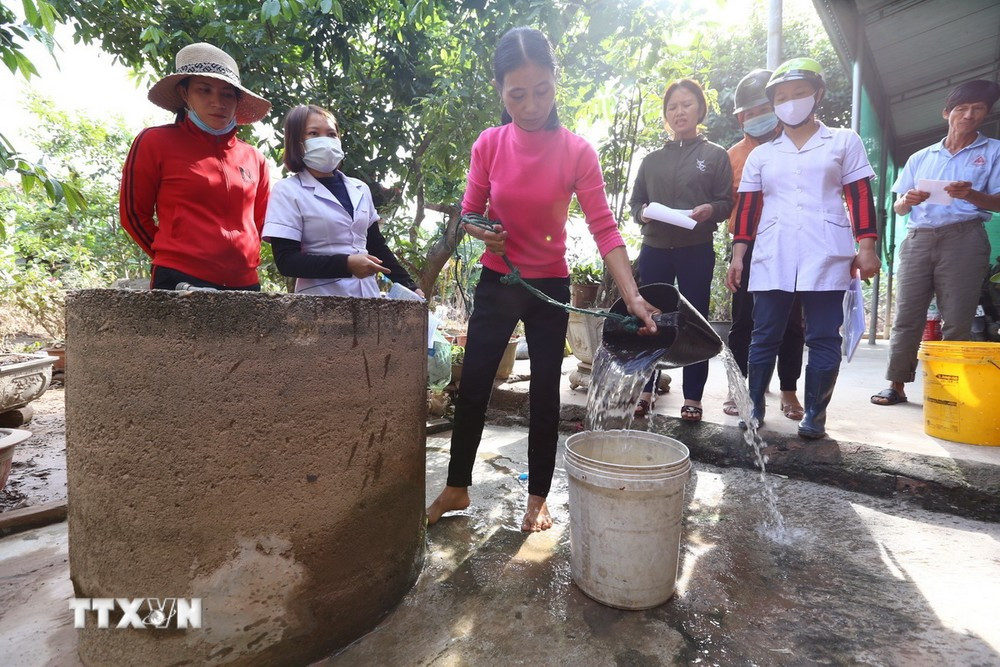People should note that even after a flood, well water that is clear must still be disinfected before use, and disinfected water must still be boiled before drinking.

After each storm or flood, water sources in flooded areas are often seriously polluted.
Here are some ways to treat water sources that people can do themselves to have clean water.
The drinking water treatment process includes 3 basic steps: clarifying, disinfecting and boiling. The water after boiling and cooling can be drunk.
Made in water
Use 1g of alum (a piece as big as half a finger joint) for 20 liters of water.
Dissolve an amount of alum equivalent to the volume of water to be clarified into a ladle of water, then pour it into a jar, pot, barrel, or water tank and stir well. Wait about 30 minutes for the sediment to settle to the bottom, then decant the clear water.
If you don't have alum, use a clean cloth to filter the water, keeping the dirt, do this several times until the water is clear.
Chemical disinfection
- Disinfect water with Chloramine B:Used for households, to disinfect small volumes of water such as jars, pots, vats, buckets, basins or small water tanks.
One 0.25g Cloramin B tablet can disinfect 25 liters of water and one 0.67g Aquatabs tablet can disinfect 20 liters of water.
- Disinfect water with powder chemicals (Chloramine B, Lime Chloride):To disinfect water sources for collectives, wells where people gather to avoid floods and must be done under the guidance of medical staff.
The chemical dosage required for disinfection is 10 mg/liter. A 30-liter water tank requires 0.5g of 27% active chlorine Chloramine B powder, or 0.4g of 20% lime chloride, or 0.12g of 70% lime chloride (HTH) for disinfection.
- How to disinfect:Dissolve the amount of chemicals needed for the amount of water to be disinfected in a ladle of water, then pour it into the tank/container and mix well.
Scoop up some water and smell it. If you don't smell chlorine in the water, add about 1/3 tablespoon of the above chemical powder to the water and stir well. Add more until the water smells of chlorine.

Then, scoop water and pour it over the tank to disinfect it. The water can be used after 30 minutes of disinfection.
Note that disinfection should not be carried out at the same time as alum treatment because alum or organic substances in the water will absorb all the active chlorine and lose the disinfecting effect of chlorine.
After disinfection, if you smell chlorine, the disinfection is effective. If you accidentally add too much chlorine, wait another 30 minutes to 1 hour for the strong smell to subside.
Disinfectant water can be used for daily activities, but must be boiled before drinking.
Currently, the most commonly used chemicals are Cloramin B in 0.25g tablet form, 27% active chlorine powder form and Aquatabs 67mg.
The principle when treating well water is that after the water has drained, the water and environment must be treated immediately, following the principle of "cleaning up as the water drains."
- For wells:Just pump out all the cloudy water and pump for another 15 minutes, then discard the water, and it can be used. Pay attention to cleaning the pump and the well floor.
- For open wells:The processing procedure needs to be more thorough with 3 steps:
Step 1: Clean the well
Drain all puddles around the well area; remove the lid and plastic covering the well; use well water to pour over the walls to wash away all the sand and trash stuck on the walls and floor of the well.
Scoop or use a pump to drain the water, then dredge the well. If dredging is not possible, choose another well to treat and share.

If all the wells in that area cannot be dredged, a temporary solution is to scoop a few dozen liters of water into a tank, then add alum and disinfect it, use it up to make another batch, wait a few days until the well water level drops, then proceed to clean it.
Step 2: Clarify the well water
Use 50g of alum for 1m3 of water, maximum 100g/m3 if the water is very cloudy. Dissolve all the necessary amount of alum in a bucket of water, pour evenly over the well, lower the bucket deep into the water and then pull it up strongly about 10 times.
Then, leave for 30 minutes to 1 hour for the sediment to settle. If there is no alum to clarify the water: make a temporary sand filter using a barrel, bucket or jar with a volume of about 20-30 liters, punch a hole with a diameter of 1cm on the wall 5cm from the bottom of the barrel, put some rocks or broken bricks on the bottom, place a piece of burlap on top and pour sand about 25-30cm thick.
Pour well water in until the water flows out clear, then use it to disinfect.
Step 3: Disinfect the well
Disinfectant: Chloramine B at a dose of 10g/m3 or 20% lime chloride (13g/m3), or 70% lime chloride (4g/m3).
How to handle: mix the above chemicals into a bucket of water, stir until completely dissolved, then pour the bucket of water evenly into the well.
Drop the bucket deep and pull it up and down about 10 times. If you don't smell chlorine in the water, add about 1/3 tablespoon of the above chemical powder and stir well. Add more until the well water smells of chlorine.
Use this well water to pour over the well wall to disinfect, then leave it for about 30 minutes before using.
Note that even after a flood, well water is clear, it must still be disinfected before use. Disinfectant water must still be boiled before drinking.
In the absence of chemical disinfectants, only drink water that has been boiled for 10 minutes or more and do not eat raw vegetables washed with unsterilized water.
TB (according to Vietnam+)